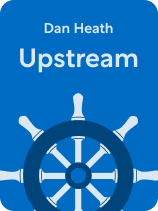

This article is an excerpt from the Shortform book guide to "Upstream" by Dan Heath. Shortform has the world's best summaries and analyses of books you should be reading.
Like this article? Sign up for a free trial here.
Do you want to solve a major problem in your organization or in society at large? How can you intentionally foster an upstream mindset with those around you?
In Upstream, business writer Dan Heath explains a strategy for focusing energy on proactive, long-term solutions: upstream problem-solving. He shares recommendations for implementing upstream solutions in any context, and he points out three roadblocks that are likely to be in your way.
Continue reading for Heath’s advice for moving upstream along with an exercise to help you implement his ideas.
3 Tips for Moving Upstream
We’ve consolidated Heath’s recommendations for moving upstream into three key tips: Gather people with a shared interest, reform systems by identifying small tweaks that can produce significant change, and use data to guide experimentation. Let’s take a look at each in detail.
Tip #1: Gather People With a Shared Interest
The first important step for upstream intervention is gathering a team of people who can tackle the problem from many angles—a process Heath calls “surrounding the problem.” Heath argues that diverse people with a shared interest can make a big difference when they align their efforts toward a common goal. He claims that if there’s nobody with explicit responsibility over a problem, it’s up to individuals to take on the challenge and recruit others who are motivated and empowered to help.
(Shortform note: Gathering a team to take upstream action is likely to benefit from different forms of diversity: variation in their professional skills or expertise as well as cognitive diversity. Cognitive diversity represents the different perspectives and ways of processing information that people have, and business research shows that more cognitively diverse teams perform better at problem-solving.)
To illustrate this advice, let’s examine the earlier example of a garbage-polluted stream. Countless people could work together to eliminate the littering problem long term: individual community members who want access to clean public spaces, conservation groups that want to maintain healthy ecosystems, schoolteachers who want to instill good values in their students, local officials who want to respond to their constituents’ concerns, and manufacturers who want to appeal to consumers’ eco-friendly values. Each of these groups has different motivating factors, but they could all benefit from taking upstream action to prevent stream pollution.
(Shortform note: One potential challenge to gathering the right team for upstream action is motivation. In The Oz Principle, Roger Conners, Tom Smith, and Craig Hickman assert that even if you feel inclined to let someone else solve a problem, you should want to take responsibility for a problem because of the benefits it offers. The authors claim that participating in the problem-solving process helps you avert a crisis, makes people think highly of you because of the important role of problem-solvers in society, and enhances your personal development through creative work and active learning.)
Tip #2: Identify Small Changes With Significant Impacts
Heath’s next piece of advice builds on the group of people who are invested in reform: Change systems rather than reacting to byproducts of bad systems. He recommends achieving this by targeting opportunities to make minor changes that have a disproportionately large impact on the problem (what Heath calls “leverage points”).
(Shortform note: In Thinking in Systems, Donella Meadows defines leverage points as places to intervene in a system. Within this definition, there are low leverage points—aspects of a system where changes will have a minimal impact—and high leverage points, where changes to a system have a big impact. One of Meadows’s examples of a high leverage point is changing the rules of a system (things like laws, contracts, and incentives) as well as changing who gets to set the rules.)
In one of Heath’s examples, the travel booking company Expedia eliminated nearly 20 million customer support calls every year simply by changing its booking system to ensure that customers received a copy of their travel itinerary immediately after making the reservation. This ensured travelers had all the information they needed without having to request it via phone. By zeroing in on this upstream leverage point, the company drastically reduced the time and money spent on this simple customer request.
(Shortform note: One strategy that may have identified this leverage point sooner at Expedia is actively soliciting feedback from employees about what’s working and what isn’t. Feedback from the customer support employees might have clarified early on that most of the calls were requests for an itinerary. Creating a trusting environment for people to provide feedback might give business managers an opportunity to spot upstream problem areas quickly.)
Tip #3: Use Data to Experiment Continuously
Heath’s third component of upstream intervention is using data to guide and tweak experimental solutions. The benefits of upstream problem-solving are not always immediately obvious. Heath writes that in some areas—like preventive health care or changing a relationship dynamic—it could take years to see a significant change in outcomes. As a result, it’s important to be patient with the process and identify relevant metrics that you can continuously monitor to ensure that you’re headed in the right direction.
Heath contends that ample data allows you to not only identify early warning signs of a problem—to avoid being forced to react rather than prevent—but also allows you to track progress toward a goal and improve your strategy.
An increase in the volume of non-biodegradable materials purchased locally might serve as an early warning sign that the problem will get worse, assuming that the prevalence of these materials contributes to the littering crisis. Heath suggests that trends in these areas could indicate success for the various stakeholders or indicate a need to change course. He emphasizes that you don’t have to predict the best solution from the beginning; you just have to respond accordingly to what the data shows.
3 Challenges in Moving Upstream
Now that we’ve covered the three key aspects of upstream problem-solving, we’ll describe some of the challenges that Heath says to look out for as you implement these strategies. These potential roadblocks include metrics that falsely indicate success (what Heath calls “ghost victories”), unintended consequences that exacerbate the initial problem, and a mismatch between the people who contribute to solutions and those who benefit from them. We’ll describe these common challenges in more detail.
Challenge #1: Data-Related Problems
Heath contends that there are multiple ways for data to fall short when it comes to accurately indicating the success of upstream efforts. Therefore, it’s important to constantly reevaluate the metrics you’re using to measure progress. The first potential problem with data occurs when an overall trend driven by external factors gives the illusion that your specific efforts are driving change.
Heath writes that the second data problem arises when the metrics for tracking upstream intervention don’t align with the overall goal.
Lastly, Heath explains that a metric for short-term efforts can morph into the end goal rather than a means to a larger change. Heath suggests that one potential solution to this challenge is to pair two complementary metrics together to ensure that you’re moving toward the initial goal.
Challenge #2: Unintended Negative Consequences
Heath warns that, in addition to challenges related to data, there can also be unintended negative consequences of upstream intervention. For example, at a company with low customer satisfaction, managers might decide that they need to redesign their products to make them easier to use. However, the end result might leave customers even more dissatisfied than before because the new product design doesn’t look as aesthetically pleasing as it used to.
Heath’s solution to this challenge is staying vigilant to unintended outcomes and adjusting your strategy when the need arises.
(Shortform note: On the flip side of this possibility that your upstream problem-solving will have unintended negative consequences, it’s also possible that your actions will have positive outcomes that you didn’t expect. For example, in User Friendly, Cliff Kuang and Robert Fabricant explain that when engineers design a new product to be user-friendly for disabled people, it’s likely to also benefit the general population. One of Kuang and Fabricant’s examples is the Oxo vegetable peeler: It was designed for people with arthritis who have trouble gripping narrow, metal peelers. But, in general, people found it more comfortable to use, and it inspired a widely popular design component in many kitchen utensils.)
Challenge #3: Mismatch in Contributors and Beneficiaries of Upstream Change
The last challenge of upstream work that Heath discusses is a mismatch between the people who are empowered to do the upstream intervention and those who benefit from those solutions. Heath writes that upstream intervention often requires costly or time-consuming initiatives, and it might not always seem worth it for people to make the effort or investment.
For example, consider a business scenario where improving customer satisfaction requires labor-intensive efforts by lower-ranking employees. However, those employees won’t benefit from the increase in customer satisfaction and a subsequent increase in the company’s profitability—they might get the same wages while the customers and shareholders receive the benefits. This could lead to a lack of motivation and failure to achieve the long-term goal.
(Shortform note: A couple of potential strategies for motivating someone to help with upstream interventions include explaining to the person why they would be uniquely qualified to support the effort and giving the person the autonomy to decide how they’ll work.)
Heath explains that, to combat this challenge, it’s important to ensure that everyone involved in the upstream efforts has a vested interest in the overall goal, whether it’s financial, moral, or ideological. This also applies when an organization or business has to provide financial investment for upstream work and the monetary return on their investment is not guaranteed. For example, it may not improve a company’s profitability to pay for their employees to take sabbatical leave, but the executives might still decide that it’s worth making this upstream investment because they value the long-term well-being of the employees.
(Shortform note: This mismatch problem that Heath identifies might also be addressed by obtaining funding for upstream work from public institutions that are tasked with ensuring people’s well-being rather than making a profit. This could include government funding for social programs or funding from non-profit organizations that are focused on community issues. In these cases, the organizations are more likely to provide financial investment for the long-term goal of social benefits.)
Exercise: Create a Plan for Upstream Intervention
Once you identify a problem that you want to take responsibility for, Heath’s advice for upstream intervention includes three key components: gathering a team of people who are invested in solving the problem, making small changes with a large potential impact, and using data to experiment with different interventions. In this exercise, we’ll walk through each of these steps to help you implement an upstream change in your life.
- Write down an ongoing problem in your life that you’d like to take responsibility for. It could be a challenge in your personal life, a problem in your business, or a community-level problem like a lack of places in your neighborhood to buy healthy food. How does the problem impact you in the short term and the long term?
- Next, brainstorm the root causes of the problem by writing down a few upstream contributing factors. How does each of these upstream factors play a role in the long-term outcome or problem?
- Now that you’ve considered some potential root causes, identify different people who might also want to solve the problem through upstream action. For each of these people, what unique skills or perspectives could they offer in the problem-solving process?
- Make an action plan to begin addressing some of the root causes you identified, focusing on small changes that will have a big impact. Write down your first step and the timeframe for doing it.
- Identify ways to track your progress toward the overarching goal: Write down a few metrics that will help you measure your success and explain how each of the metrics aligns with your goal. Include a timeframe for how frequently you’ll review your data to assess how effective your strategy is (every week or every month, for example).

———End of Preview———
Like what you just read? Read the rest of the world's best book summary and analysis of Dan Heath's "Upstream" at Shortform.
Here's what you'll find in our full Upstream summary:
- Why you need to get to the root of a problem rather than applying band-aids
- Guidelines for implementing upstream solutions to solve problems
- How to solve problems before they happen






